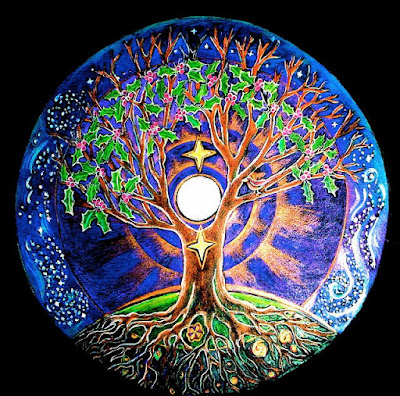In the United States the exact moment of the Winter Solstice
as defined by scientists—when the Sun
is shining farthest to the south directly over the Tropic of
Capricorn—occurs at 3:47 pm Central Standard Time today. You can figure
out its arrival in your neck of the woods. The fact is that last
night was the longest night of the year and today the sky will begin to grow light
earlier each day.
In most so-called pagan traditions around the Northern
Hemisphere there were two ways
to celebrate the Solstice. Some lit fires
in the darkest night to summon the return of the Sun. Others gathered at dawn to in some way capture the first light of that
return. The latter often involved human construction on or in which that light would strike a significant stone or altar. Think pyramids in Egypt and the
pre-Columbian Americas, Stonehenge, Greek temples, Native American medicine wheels, certain Medieval Cathedrals,
and far simpler wooden structures in Northern Europe
and Siberia. Either way, those who observe or re-create
such rituals have found a way to do so.
Even if you do not observe the pagan doings—or shun them as
the devil’s work—chances are that you to have been or will be
celebrating the solstice yourself.
Buried in traditional folklore,
swathed in symbolism, and steeped in
metaphor, Christmas and Chanukah share
the same impulses as Nordic Yule and
its Celtic and ancient British cousins, Meán Geimhridh and Meán Geimhridhh beloved by contemporary neo-pagans of
one stripe or another. At their core there was in each of them a physical or metaphorical re-kindling of
the light at the darkest hour of the year offering a glimmering of hope
at a time of cold and starvation.
Other celebrations were connected
to the solstice or mid-winter including the Feast of Santa Lucia
as it is celebrated in Scandinavia, St. Stephen’s or Wren
Day, New Years, and
even Kwanza.
While the trappings of Christmas—the
Yule log, the holly and the ivy, the Christmas tree, mistletoe, wassailing and other customs are commonly known to be borrowed from
pagan celebrations, the metaphor of
the birth of the Son, bringing light and salvation to
the world is often overlooked. Among
still nervous orthodox Christians,
drawing parallels to pagan belief is still actively discouraged.
The early Church actively squelched efforts to confabulate the Feast of the Nativity with
the Festival of Sol Invictus,
introduced to the Roman Empire in
the Third Century under the Emperor Elagabalus. It was a religious revolution that
briefly upended Jupiter as the primary Roman God and put in his
place the Invincible Sun, which combined the characteristics and cult
practices of several sun gods including Syrian Elah-Gabal, the Greek Apollo, and Mithras, a soldier god of Persian
origin.
The feast was set on December 25, during the Roman holiday
period following Saturnalia. Later, under the Emperor Aurelian as Christianity grew in influence and importance, attempts were made to incorporate worship
of the Christ child into the cult as an incarnation of Sol. When
the Church became ascendant in the Empire,
it did all it could to squelch the festival, but like many popular pagan customs, it was so integrated into many daily lives that
it inevitably influenced how Christmas, by then assigned to the same
calendar day, was observed.
Well more than a millennium
later the English poet Christina
Rossetti, a member of the Pre-Raphaelite movement, and a devout Christian drew the clear
connection between Christmas and solstice in her poem In the Bleak Midwinter.
In addition to the carol that was set to Rossetti’s poem
which is now associated with the Solstice, modern neo-paganism has given
rise to a number of solstice hymns.
Today we will celebrate with one of the loveliest, A Winter’s Carol by Tori Amos which she featured on her 2009 album Midwinter Graces. In
2013 she reworked the song as Coronation, the closing number for
her London musical The Light Princess which featured her songs and lyrics and the libretto by Australian playwright and screenwriter
Samuel Adamson. Since
the highly regarded Royal National
Theatre production never made it to Broadway—it
was considered too esoteric—the
original version is much better known to American audiences and is treasured
by neo-pagans.




No comments:
Post a Comment